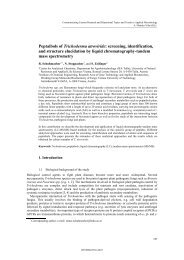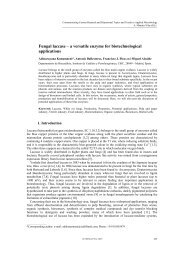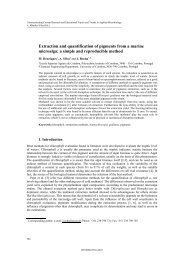Why do food and drink smell like earth? - Formatex Research Center
Why do food and drink smell like earth? - Formatex Research Center
Why do food and drink smell like earth? - Formatex Research Center
Create successful ePaper yourself
Turn your PDF publications into a flip-book with our unique Google optimized e-Paper software.
Communicating Current <strong>Research</strong> <strong>and</strong> Educational Topics <strong>and</strong> Trends in Applied Microbiology<br />
_____________________________________________________________________<br />
A. Méndez-Vilas (Ed.)<br />
imply a low amount of patulin. Related to this, [10] demonstrated that P. expansum was isolated<br />
frequently from rotted grapes that had an off o<strong>do</strong>ur. So the implication is that the o<strong>do</strong>ur is present<br />
because there is a large amount of P. expansum biomass. Hence patulin may also be present. Equally, B.<br />
cinerea is known to produce a wide-range of metabolites, some with known biological activity (see<br />
above) <strong>and</strong> involved intimately with pathogenicity.<br />
Paterson [24] indicated that patulin could be stimulated by the use of glucose analogues such as 2deoxy-D-glucose<br />
<strong>and</strong> fungicides. Production of patulin is highly influenced by nutrient quality <strong>and</strong><br />
quantity. There is no direct evidence for patulin inhibiting B. cinerea. Furthermore, to reduce algal<br />
populations <strong>and</strong> associated biosynthesis of geosmin, copper sulphate is often applied to aquatic systems.<br />
Cultures of P. expansum grown on increasing concentrations of copper sulphate accumulated more<br />
biomass than untreated controls. In addition, copper-treated mycelium contained greater concentrations<br />
of geosmin than untreated controls [25]. Such phenomena need to be borne in mind when applying<br />
fungicides to fruit etc. Interestingly, the bacterium Burkholderia cepacia produces a compound which<br />
inhibits B. cinerea <strong>and</strong> may be a possible control compound [26]. This demonstrates that B. cinerea can<br />
be controlled by a compound other than commercial fungicides <strong>and</strong> which is produced biologically.<br />
Geosmin <strong>and</strong> patulin are known to be sensitive to physical/chemical conditions. The addition of<br />
sulphur dioxide generating compound, at normal levels (100 mg/L) to a sample containing 25 mg/L of<br />
patulin caused the patulin to decrease to about one-half in 15 min [27]. Geosmin degrades to aroma-free<br />
metabolite in acidic conditions. Patulin is also sensitive to pH <strong>and</strong> other conditions such as proteins with<br />
cysteine residues, <strong>and</strong> sulphur dioxide in general. Patulin is normally considered to be degraded to other<br />
compounds during fermentation <strong>and</strong> so may not be expected to be present in wine. The effect of<br />
fungicides needs to be considered on mycotoxin <strong>and</strong> geosmin production as <strong>do</strong> other control methods<br />
such as biocontrol.<br />
Patulin production in culture has been shown to occur when growth rate diminishes because of<br />
limitations on cell growth such as nitrogen consumption [28]: there is no equivalent information for<br />
geosmin. It is clear that patulin is increasingly stable at low pH [29], geosmin tends to degrade to a<br />
compound without an o<strong>do</strong>ur, <strong>and</strong> so if was produced in such circumstances it would not accumulate.<br />
Many biocontrol fungi have been used as potential controls for the B. cinerea. Trichoderma hiazaria<br />
is perhaps the most cited at the present time. Various others have been suggested including<br />
representatives of the penicillia. A preparation of T. harzianum was sprayed on cucumber plants in<br />
greenhouses in order to control fruit <strong>and</strong> stem grey mould. Biological control of grey mould was also<br />
suggested by Newhook [30] who sprayed tomato plants with Cla<strong>do</strong>sporium herbarium <strong>and</strong> Penicillium<br />
sp., reducing the incidence of grey mould of fruits. Sufficient control of B. cinerea by isolates of<br />
Trichoderma <strong>and</strong> Gliocladium spp. was reported on grapes [31]. Biocontrol of P. expansum is also<br />
suggested [24].<br />
Increasing concentrations of CaCl2 (25-175 mM) resulted in decreased spore germination <strong>and</strong> germtube<br />
growth of B. cinerea <strong>and</strong> P. expansum. The greater effect was observed with B. cinerea. Glucose<br />
overcame the inhibitory effect. MgCl2 (25-175 mM) had no effect on these parameters, indicating that<br />
the calcium cation rather than the chloride anion was responsible. The pectinolytic activity of crude<br />
enzyme obtained from the culture medium of both pathogens was also inhibited by CaC2, <strong>and</strong> with the<br />
greatest effect on the crude enzyme from P. expansum. Obviously, the pectinase effect may be<br />
independent of the spore <strong>and</strong> germ-tube effect from this observation. Further, the biocontrol activity of<br />
C<strong>and</strong>ida oleophila was enhanced by the addition of 90 or 180 mM CaCl2. The effect of C. oleophila in<br />
the presence of calcium ions was due to the inhibitory effects of the ions on pathogen spore germination<br />
<strong>and</strong> metabolism. It was also demonstrated that, when using the antagonist Pseu<strong>do</strong>monas syringae, the<br />
addition of specific amino acids (L-asparagine <strong>and</strong> L-proline) enhanced biocontrol activity against P.<br />
expansum. This was from the ability of the bacterium to out-compete the fungus for the nitrogen source,<br />
leading to enhanced growth of the bacterium in wound sites. Several other amino acids that were<br />
selectively utilized by the antagonist <strong>and</strong> not by the pathogen [32]. It would of course be useful to test B.<br />
cinerea under such conditions to compare with P. expansum. In general, the effects on patulin <strong>and</strong><br />
geosmin production need to be determined.<br />
©FORMATEX 2007<br />
125









